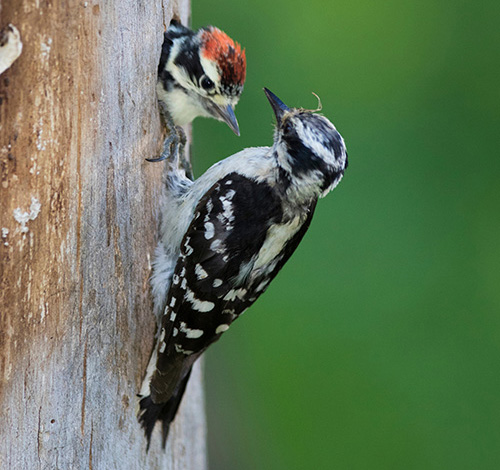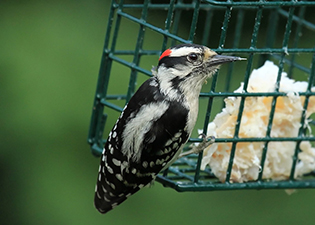Seriously? "Knock on Wood?"
Seriously? "Knock on Wood?"

(Photo courtesy of Mircea Costina)
By Bill Willis and Jeff Church
August 22, 2018
- Some mammals and birds are just born hardheads
- Woodpeckers either build a new nesting cavity in a dead tree or remodel an existing one
- The brain is encased in spongy bone that absorbs the impact of drilling a hole
- Anatomical features protect the tongue, nostrils, and eyes
- Federal and state laws protect woodpeckers from being captured or killed
“Knock on Wood.” How many times have you heard that sound or saying? Humans knock on something wooden to assure continued good luck. Perhaps it has extra meaning if you happen to be an avian head-banger and want to insure continuous good luck for “more is always better”.
How many different woodpeckers can be found in North Carolina?
North Carolina hosts eight species of native woodpeckers from the abundant Downy, Hairy, Northern Flicker, Red-bellied, Yellow-bellied sapsucker, Pileated, Redheaded to the rarer Red-cockaded Woodpecker.

(Photo courtesy of Maria Corcacas)
What is the diet of the local woodpeckers?
The diet consists of ants, beetles, tree sap, and plant material. The woodpeckers and hummingbirds will visit the sapsucker holes to catch the insects that come to the sap. Both a suet and seed feeder will provide nourishment for woodpeckers.
Why do these birds peck on trees or wood?
There are several reasons for this activity. A male announces his presence to a possible mate, other birds are drilling for larva and insects, extracting sap, or actual nest building. Downy woodpeckers, being the smallest North American woodpecker, about the size of the Eastern Nuthatch, are able to use birdhouses intended for nuthatches and blue birds with minimal effort.
How fast can they strike a tree and at what impact?
The rate of pecks can reach 100 per min at 15 mph; a full day’s work could reach 12,000 pecks. That is a remarkable number considering the bird’s potential 10-year life span. The force of the woodpecker’s head hitting a tree was estimated at 1000 - 1500 g-force units. Humans can receive concussions at 90 – 100g in a highspeed vehicle crash. Other comparisons are high speed rollercoaster 3.5-6.3g; Apollo 16 reentry 7.19g or direct boxer blow 52g.
Why don’t they get brain damage?

(Photo by Bet Zimmerman)
The stresses on the neck, face, and skeleton might demand stopping every four hours to take headache medication. However, powerful neck muscles, a flexible spine and a tongue that wraps around the skull afford head protection. Other structural features include uneven lengths of upper and lower beaks that lessen force transmission to the head but rather direct it to the rest of the body. A supportive, thick and spongy bone loops around the brain and acts as a safety belt in reducing shocks/concussions.
What are other anatomical features aid the woodpecker?
Unlike songbirds that have three toe claws forward and 1 rear, the woodpecker has 2 forward toe claws and 2 rear ones, providing better traction on the side of trees. Their stiff tail also has a spike that helps the woodpecker anchor and balance on the side of the trees. Feathers protect the nostril area to keep sawdust out and a special third eye membrane protects the eyes. They’re pretty well prepared for the work at hand.
What poses a threat to woodpeckers?
Loss of habitat and the use of pesticides have negative impacts on woodpecker populations. Woodpeckers can become backyard visitors if food, water, shelter, and nesting sites are provided. They will also be drawn to feeders.
What can we do to discourage woodpecker damage without harming the bird?
The woodpecker is the driller, pecker, and drummer in the forest. He will hammer for various reasons such as attracting a mate, extracting insects, or building a nest. If he can be attracted or redirected to another location by meeting his needs better elsewhere, that would be a good approach. There are other methods involving motion, reflection, scare tactics, or decoys that might prove helpful.
Trapping or killing woodpeckers is illegal!
Who is the most famous woodpecker?
Woody Woodpecker
Sit back and enjoy the “Sound of Music” with a touch of percussion.



